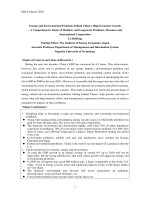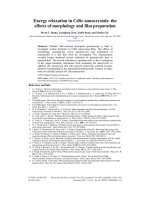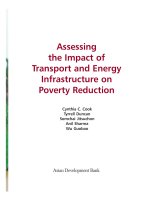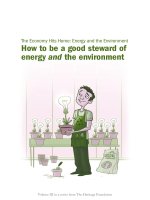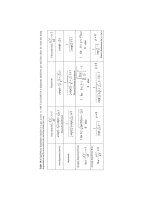- Trang chủ >>
- THPT Quốc Gia >>
- Hóa
Flow of energy and matter
Bạn đang xem bản rút gọn của tài liệu. Xem và tải ngay bản đầy đủ của tài liệu tại đây (2.94 MB, 10 trang )
Life Sciences
Standards
Preview
2.c. Students know decomposers,
including many fungi, insects, and
microorganisms, recycle matter from
dead plants and animals.
Standard Set 2. Life Sciences
2. All organisms need energy and
matter to live and grow. As a basis for
understanding this concept:
Standard Set 3. Life Sciences
2.a. Students know plants are the
primary source of matter and energy
entering most food chains.
3. Living organisms depend on one
another and on their environment for
survival. As a basis for understanding
this concept:
2.b. Students know producers and
consumers (herbivores, carnivores,
omnivores, and decomposers) are
related in food chains and food webs
and may compete with each other for
resources in an ecosystem.
3.d. Students know that most
microorganisms do not cause disease
and that many are beneficial.
by Katie Deutsch
Genre
Nonfiction
Comprehension Skill
Follow Instructions
Text Features
•
•
•
•
Captions
Diagrams
Call Outs
Glossary
Science Content
The Roles of
Living Things
Scott Foresman Science 4.3
ISBN 0-328-23546-6
ì<(sk$m)=cdfegj< +^-Ä-U-Ä-U
Vocabulary
carnivore
consumer
decomposer
ecosystem
food chain
food web
herbivore
microorganism
omnivore
producer
by Katie Deutsch
Picture Credits
Illustrations
11 Adam Benton.
Photographs
Every effort has been made to secure permission and provide appropriate credit for photographic material. The
publisher deeply regrets any omission and pledges to correct errors called to its attention in subsequent editions.
Unless otherwise acknowledged, all photographs are the copyright of Dorling Kindersley, a division of Pearson.
Photo locators denoted as follows: Top (T), Center (C), Bottom (B), Left (L), Right (R), Background (Bkgd).
Opener: ©Zig Leszczynski/Animals Animals/Earth Scenes, ©George D. Lepp/Corbis; 3 (R) ©Roger Phillips/DK Images;
4 (B) ©John Cancalosi/Nature Picture Library; 5 (TR) ©Frank Lane Picture Agency/Corbis, (TL) ©Tim Fitzharris/Minden
Pictures, (BL) ©Zig Leszczynski/Animals Animals/Earth Scenes; 6 (TL) ©Mark L. Stephenson/Corbis; 7 (BL) ©Naturfoto
Honal/Corbis; 8 (B) Neil Fletcher and Matthew Ward/©DK Images, (TR) ©John Gerlach/Animals Animals/Earth Scenes;
9 (BL) ©Michael Sewell/Peter Arnold, Inc., (TR) ©George H. H. Huey/Corbis; 10 (BR) ©Sally A. Morgan/Corbis; 12 ©Steve
Gschmeissner/Photo Researchers, Inc.; 13 (B) ©Andrew Syred/Photo Researchers, Inc.; 14 (BC) ©Dr. Jeremy Burgess/
Photo Researchers, Inc.
ISBN: 0-328-23546-6
Copyright © Pearson Education, Inc. All Rights Reserved. Printed in the United States of America.
This publication is protected by Copyright, and permission should be obtained from the publisher prior to any
prohibited reproduction, storage in a retrieval system, or transmission in any form by any means, electronic,
mechanical, photocopying, recording, or likewise. For information regarding permission(s), write to
Permissions Department, Scott Foresman, 1900 East Lake Avenue, Glenview, Illinois 60025.
1 2 3 4 5 6 7 8 9 10 V010 13 12 11 10 09 08 07 06
How does energy
flow?
Energy in Living Things
An ecosystem is all the living and nonliving
things in an environment and the many ways they
interact. One kind of ecosystem is a redwood forest.
All living things need water, nutrients, and enough
space. They need temperatures that let them grow and
make young living things.
All of these things take energy. Living things use
energy to grow and to stay alive.
Sources of Energy
Where does all this energy come from? Most of it
comes from the Sun. The Sun’s energy flows through
all living things in an ecosystem. The energy changes
form as it flows through an ecosystem.
The flow of energy starts in plants. Green plants
use energy from the Sun to change carbon dioxide
and water into food and oxygen. This is called
photosynthesis. Plants live and grow on the food they
make. Some of the energy is stored in the roots, leaves,
and fruits of the plant. Plants are called producers
because they make their own food. Green plants are
the only producers in most ecosystems.
A redwood tree lives in a forest ecosystem.
This plant uses energy from
the Sun to make food.
2
3
How Energy Flows
People and animals must get energy by eating, or
consuming, plants or other animals. Consumers are
living things that eat other living things as food.
The Sun’s energy is stored in plants. When animals
eat plants, they get that energy. Herbivores are
animals that eat plants. Animals use the energy they
get from eating to live and grow. Some energy gets
stored in their bodies.
Carnivores are animals that eat other animals. As
one animal eats another, the stored energy flows from
one to the other. Some animals are omnivores. They
eat both plants and other animals. Scavengers eat dead
and decaying plants and animals.
Plants and animals leave wastes. They also die.
Decomposers are organisms that break down plant
and animal waste and remains. Some insects, fungi,
and bacteria are decomposers.
Look at the diagram of the Mojave Desert
ecosystem. The bighorn sheep and chuckwalla are
herbivores, while the ring-tailed cat is an omnivore.
The desert sidewinder is a carnivore, and the turkey
vulture is a scavenger.
Bighorn
sheep
Chuckwalla
This turkey vulture scavenges for
animals that have already died.
Ring-tailed
cat
Desert
sidewinder
4
Turkey
vulture
5
How does matter
flow?
A redwood forest has a lot of biomass. Biomass is the
mass of living matter. Plants give the energy and the
biomass that most other living things need.
Along with sunlight, plants also take in carbon,
nitrogen, oxygen, and hydrogen. They get these
elements from the soil, air, and water. They use them
to make their living parts. When animals eat plants,
energy and matter go from the plants to the animals.
In a food chain, organisms transfer
energy by eating and being eaten. Look
at the food chain shown on this page
and the next. Which living things are
producers? Which are consumers?
Links in a Food Chain
A food chain’s first link is a producer. The producer
in nearly all ecosystems is a plant.
Mice and golden eagles are part of this food chain.
Mice also eat the grasses’ seeds. Mice are first or primary
consumers in this food chain. They get energy and
matter from the grasses.
A predator is an animal that hunts other animals
for food. The hunted animals are its prey. The golden
eagle is a predator. The mice are its prey. A predator
gets its energy and matter from eating its prey.
Food chains may have consumers at different
levels. The golden eagle is at the top of this food chain.
Animals at the top of a food chain have few predators.
Golden eagles are
secondary consumers.
Energy comes into the food
chain as sunlight.
Meadow grasses and other
plants are producers.
Energy and matter flow from
plants to animals such as mice.
They are primary consumers.
6
7
Food Webs
Changing Food Webs
Many food chains cross and connect in one
ecosystem. A food web is a system of overlapping
food chains. Energy and matter flow through the many
branches of a food web.
What would happen if the ecosystem suddenly had
fewer mountain lions? More black-tailed jackrabbits
would survive. In fact, more herbivores of all kinds
would live.
More herbivores would mean more food for spotted
owls. Also, more plants would be eaten. This would
lead to fewer plants, and soon, fewer herbivores.
All living things depend on other living things to
live. A change in a food web affects all parts.
What’s Missing
This picture leaves out a big part of an ecosystem.
Decomposers break down dead plants, animals, and
their wastes. The decomposers return matter to the soil
and air. Then the producers can use it all over again.
Sun
Black-tailed jackrabbit
Mountain lion
Plants
8
Spotted owl
9
What are
decomposers?
The Role of Decomposers
Ecosystems need decomposers. Without them, an
ecosystem’s nutrients would get used up. Everything
would die.
Decomposers break down wastes and
dead plant and animal material. They
live on the food energy that can still be
found in these materials. They return
nutrients to the soil and water. Living
things then use those nutrients.
Types of Decomposers
Did you ever find a brown spot on a peach?
Decomposers make these spots. Slugs, earthworms,
and flies are decomposers that are big enough to
see. Bacteria and fungi are decomposers that are too
small to see. A living thing too small to see without a
microscope is called a microorganism.
Decay in Ecosystems
Rot, or decay, is part of any ecosystem. If things
never rotted, dead organisms and wastes would pile
up. Nutrients would not be returned to the ecosystem.
A warm temperature, water, and oxygen speed
up decay. Scavengers such as insects also help the
decomposers by feeding on dead plants and animals.
Recycling Dead Matter
Decomposers return
resources to the air and soil as
they eat dead material. As they
eat , decomposers make space
for new living things.
The banana slug is a
decomposer. It eats material it
finds on the forest floor.
Slime mold decomposes
matter and eats bacteria.
Decomposers are breaking
down this saguaro cactus.
10
11
What is the role of
microorganisms?
Microorganisms
Microorganisms live in the air, soil, and water.
Some are on your skin and inside your body. Most of
them won’t hurt you. Many help living things survive.
There are far more tiny life forms in an ecosystem
than ones you can see! Tens of thousands of tiny
protists may float in a liter of pond water! Many
protists have only one cell. Some, such as algae, make
their own food. Protists are the basic producers in food
webs in the waters on Earth. Other protists clean the
water by eating other microorganisms.
Diatoms, such as the two shown here,
are producers. These microorganisms
have hard cell walls.
12
Other Helpful Microorganisms
You have many helpful microorganisms in your
body. Bacteria in your intestines help you digest your
food. They also crowd out bacteria that could make
you sick. You can get helpful bacteria by eating certain
dairy products. Herbivores such as cows have bacteria
in their stomachs and intestines. Bacteria help the
animals digest the plants they eat.
Have you seen blue-green mold on a rotting
orange? This is Penicillium mold. In 1928, the Scottish
scientist Alexander Fleming realized that Penicillium
mold makes an antibiotic. Antibiotics kill some of the
bacteria that can make you sick. Since this discovery,
antibiotics have been used as medicine. Other kinds of
Penicillium are used to make some cheeses.
This is what a Penicillium
fungus looks like if you view it
through a microscope.
13
Microorganisms at Work
Observing Microorganisms
As you can see, fertile soil is full of insects. It also
holds lots of microorganisms. Just one liter of dirt can
have up to 1 trillion bacteria, 10 to 100 million protists,
and thousands of worms!
Some bacteria in the soil make a natural fertilizer.
They change the element nitrogen into a compound
that plants use to grow. Plants use this compound to
make proteins. All living things need proteins. Proteins
are part of a healthy diet.
You cannot see microorganisms with just your eyes.
But you can see them if you use a microscope.
The picture below shows microorganisms you might
be able to grow and observe. To grow microorganisms,
scientists mix hay or dried grass with the same
amount of both pond water and distilled water. They
keep the mixture at room temperature in a dark
room. After a few days scientists sample the mixture
with an eyedropper. If you looked at the sample in a
microscope, you might see some of the microorganisms
shown below. If the mixture was kept in the dark for
longer, more kinds of microorganisms might appear.
Topsoil holds billions
of microorganisms
and other living
things.
A mixture of hay
and grass can
be used to grow
microorganisms.
These tiny protists
appeared in the
mixture after a week.
You can see an ant and an
earthworm in the soil. Many
decomposers are too small to see.
14
15
Glossary
What did you learn?
1. What happens during photosynthesis?
carnivore
an animal that eats other animals
consumer
a living thing that eats other living things
for food
decomposer
an organism that breaks down wastes and
remains of other organisms
ecosystem
the living and nonliving things and the
ways they interact in an environment
food chain
the transfer of energy and matter from one
living thing to another by eating and being
eaten
food web
a system of overlapping food chains in
which energy and matter flow through
many branches
herbivore
an animal that eat plants
microorganism a living thing too small to be seen without
a microscope
omnivore
an animal that eats both plants and
animals
producer
a living thing that makes its own food
16
2. What do scavengers do?
3. What is biomass?
4.
You learned about Alexander Fleming
and his work with Penicillium. Using an encyclopedia and
other sources of information from your library-media center,
write a paragraph that includes more details about the work
Fleming did with Penicillium.
5.
Follow Instructions Suppose one of your classmates does
not understand what decomposers are and what their role is
in ecosystems. Write instructions that will help your
classmate understand decomposers and what they do.



